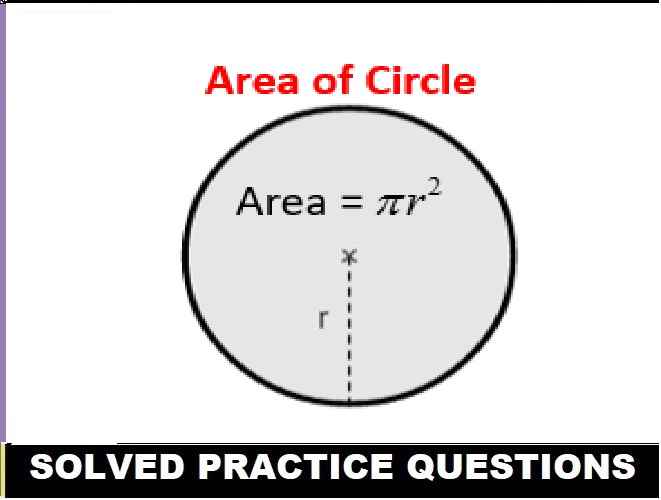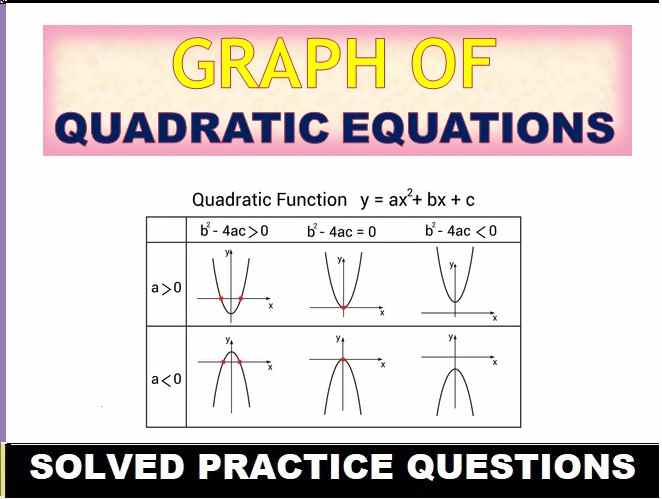Mensuration ICSE Class-7th Concise Selina mathematics Solutions Chapter-20. We provide step by step Solutions of Exercise / lesson-20 Mensuration for ICSE Class-7 Concise Selina Mathematics. Our Solutions contain all type Questions with Exe-20 A and Exe-20 B to develop skill and confidence. Visit official Website CISCE for detail information about ICSE Board Class-7 mathematics.
Mensuration ICSE Class-7th Concise Mathematics Selina Solutions Chapter-20
–: Select Topics :–
Exercise – 20 A Mensuration for ICSE Class-7th Concise Selina mathematics
Question 1.
The length and the breadth of a rectangular plot are 135 m and 65 m. Find, its perimeter and the cost of fencing it at the rate of ₹60 per m.
Answer
Given:
Length (l) = 135 m
Breadth (b) = 65 m
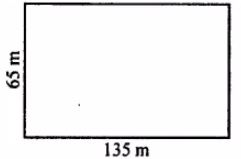
Perimeter = 2 (l + b)
= 2 (135 + 65)
= 2 (200)
= 400 m
∴ Perimeter of rectangular plot is = 400 m
Cost of fencing per m = ₹60
∴ Cost of fencing 400 m = ₹60 × 400 m = ₹24000
Question 2.
The length and breadth of a rectangular field are in the ratio 7 : 4. If its perimeter is 440 m, find its length and breadth. Also, find the cost of fencing it @ ₹150 per m.
Answer
Given : Perimeter = 440 m
Let the length of rectangular field = 7x and breadth = 4x
2(l + b) = Perimeter
2(7x + 4x)
= 440m
2(11x)
= 440m
22x = 440m
x =440/22
x = 20m
so Length = 7x = 7 x 20
= 140m
Breadth = 4x = 4 x 20 = 80m
Cost of fencing per m = ₹150
Cost of fencing 440 m = ₹150 x 440
= ₹66,000
Question 3.
The length of a rectangular field is 30 m and its diagonal is 34 m. Find the breadth of the field and its perimeter.
Answer

Question 4.
The diagonal of a square is 12 cm. Find its perimeter.
Answer
Diagonal of square = Its side x√2
Side
√2=√2√2
i.e. side = 12 cm
Perimeter of a square = 4 × side
= 4 × 12 = 48 cm
Question 5.
Find the perimeter of a rectangle whose length = 22.5 m and breadth = 16 dm.
Answer
Length = 22.5 m
Breadth = 16 dm = 1.6 m
Perimeter of rectangle = 2(l + b)
= 2(22.5 + 1.6)
= 2(24.1)
= 48.2 m
Question 6.
Find the perimeter of a rectangle with length = 24 cm and diagonal = 25 cm
Answer
Length of a rectangle (l) = 24 cm, Diagonal = 25 cm
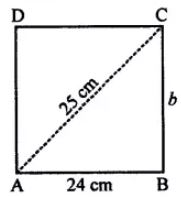
Let breadth of the rectangle = b m
Applying Pythagoras Theorem in triangle ABC,
We get, (AC)2 = (AB)2 + (BC)2
(25)2 = (24)2 + (b)2
625 = 576 + (b)2
625 – 576 = b2
49 = b2
7×7 = b
∴ b = 7 cm
Now, perimeter of the rectangle
= 2(1 + b)
= 2(24 + 7)
= 2(31)
= 62 cm
Question 7.
The length and breadth of rectangular piece of land are in the ratio of 5 : 3. If the total cost of fencing it at the rate of ₹48 per metre is ₹19,200, find its length and breadth.
Answer
Ratio in length and breadth of a rectangular piece of land = 5:3
Cost of fencing = ₹19,200
and rate = ₹48 per m
∴ Perimeter =19200/48
= 400 m
Let length = 5x.
Then breadth = 3x
∴ Perimeter = 2(l + b)
400 = 2(5x + 3x)
400 = 2 × 8x = 16x
∴ 16x = 400
⇒ x = 40016 = 25
∴ Length of the land = 5x = 5 × 25 = 125 m
breadth = 3x = 3 × 25
= 75 m.
Question 8.
A wire is in the shape of square of side 20 cm. If the wire is bent into a rectangle of length 24 cm, find its breadth.
Answer
Side of square = 20 cm
Perimeter of square = 4 × 20 = 80 cm
Or perimeter of rectangle = 80 cm
Length of a rectangle = 24 cm
∴ Perimeter of a rectangle = 2(l + b)
b = (80/2)-24
b = 40 – 24 = 16 m
Question 9.
If P = perimeter of a rectangle, l= its length and b = its breadth find :
(i) P, if l = 38 cm and b = 27 cm
(ii) b, if P = 88 cm and l = 24 cm
(iii) l, if P = 96 m and b = 28 m
Answer
(i)
Length = 38 cm
Breadth= 27 cm
Perimeter of a triangle = 2(l + b)
= 2(38 + 27)
= 2(65)
= 130 cm
(ii)
Perimeter of a rectangle = 88 cm
Length (l) = 24 cm
Let breadth = b
P = 2(l + b)
b = (P/2)-l
b = (88/2)-24
= 44 − 24
= 20 cm
∴ Breadth of a rectangle = 20 cm
(iii)
Perimeter of a rectangle = 96 m
Breadth (b) = 28 m
Let length = l
P = 2(l + b)
l =(P/2)-b
= (96/2)-28
= 48 − 42
= 20 m
∴ Length of a rectangle = 20 m
Question 10
The cost of fencing a square field at the rate of
Cost of fencing 440 m = ₹150 x 440 = ₹75 per meter is
Cost of fencing 440 m = ₹150 x 440 = ₹67,500. Find the perimeter and the side of the square field.
Answer
Length of the fence × its rate = ₹67,500
⇒ Length of the fence = ₹67500/75
= 900 m
∴ Perimeter of a square field
= length of its fence = 900 m
Since, perimeter of a square
= 4 × Length of its side
Length of the side of the square
= Perimeter/4
=900/4
= 225 m
Question 11.
The length and the breadth of a rectangle are 36 cm and 28 cm. If its perimeter is equal to the perimeter of a square, find the side of the square.
Answer
Length of rectangle = 36 cm
Breadth of rectangle = 28 cm
Perimeter of the rectangle
= 2(l + b)
= 2(36 + 28)
=2(64)
= 128 cm
Given, the perimeter of the square = perimeter of rectangle = 128 cm
so Side of the square =Perimeter/4
=128/4
= 32 cm
Question 12.
The radius of a circle is 21 cm. Find the circumference (Take π = 3 ).
Answer
Given, radius (r) = 21 cm and π =22/7
Circumference of the circle = 2πr
= 2×(22/7)×21 cm
= 2 × 22 × 3 cm
= 132 cm
Question 13.
The circumference of a circle is 440 cm. Find its radius and diameter. (Take π =
Answer
(i)
Circumference of the circle = 440 cm
Radius =(C/2π)
=(440×7)/(2×22) cm
=3088/44 cm
(ii)
Diameter = 2 × radius
= 2 × 70 = 140 cm
Question 14.
The diameter of a circular field is 56 m. Find its circumference and cost of fencing it at the rate of ₹80 per m. (Take n = )
Answer
Given, Diameter of a circular field = 56 m
so Radius =562 = 28 m
Circumference of the circle = 2πr
= 2×(22/7)×28 m
= 2 × 22 × 4 m
= 176 m
Cost of fencing of 176 m is
= 176 m × ₹80 per m
= ₹1,40,780
Question 15.
The radii of two circles are 20 cm and 13 cm. Find the difference between their circumferences. (Take π = )
Answer
Radius of 1st circle = 20 cm
Circumference of the circle = 2πr
= 2×(22/7)×20
= 8807
= 122.8 cm
The radius of 2nd circle = 13 cm
Circumference of the circle = 2πr
= 2×(22/7)×13
= 572/7
= 81.7
∴ The difference of circumference of two circles
= 122.8 − 81.7 cm
= 41.1 cm
Question 16.
The diameter of a circle is 42 cm, find its perimeter. If the perimeter of the circle is doubled, what will be the radius of the new circle. (Take π = )
Answer
Given, the Diameter of a circle = 42 cm
∴ Radius of circle = 42/2
= 21 cm
The perimeter of the circle
= 2πr
=2×(22/7)×21
= 132 cm
If the perimeter of the circle doubled
= 2 × 132 =264 cm
Radius = (C/2π)=(264/2×(2/27))
= (264×7)/(2×22)
= 42 cm
Question 17.
The perimeter of a square and the circumference of a circle are equal. If the length of each side of the square is 22 cm, find:
(i) perimeter of the square.
(ii) circumference of the circle.
(iii) radius of the circle.
Answer
(i)
Side of square = 22 cm
Perimeter of square = 4 × side
= 4 × 22
= 88 cm
(ii)
Circumference of circle
Given, Perimeter of square = Circumference of circle
= 88 cm
(iii)
Circumference of circle
= 88 cm
∴ Radius =(C/2π)
=(88×7)/(2×22)
=616/44
=14 cm
Question 18.
Find the radius of the circle whose circumference is equal to the sum of the circumferences of the circles having radii 15 cm and 8 cm.
Answer
For circle with radius = 15 cm
Circumference of circle = 2πr
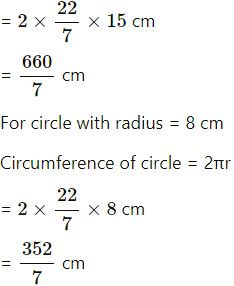
Sum of the circumferences of these two circles

= 23 cm
∴ Required radius = 23 cm
Question 19.
Find the diameter of a circle whose circumference is equal to the sum of circumference of circles with radii 10 cm, 12 cm and 18 cm.
Answer
The radius of the circle = R cm
so 2πR = 2π × 10 + 2π × 12 + 2π × 18
On dividing each term by 2π, we get:
R = 10 + 12 + 18
= 40 cm
so Radius of the circle obtained = 40 cm
And, its diameter = 2 × Radius
= 2 × 40 cm
= 80 cm
Question 20.
The circumference of a circle is eigth time the circumference of the circle with radius 12 cm. Find its diameter.
Answer
Radius of the given circle = 12 cm
Circumference of the given circle = 2πr
= 2×(22/7)×12=(528/7) cm
Circumference of the required circle
= 5×(528/7)
=2640/7 cm
If the radius of the required circle = R cm
Its circumference = 2πR
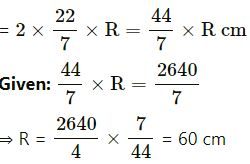
∴ Required radius = 60 cm
Question 21.
The radii of two circles are in the ratio 3 : 5, find the ratio between their circumferences.
Answer
The ratio of the radius of the circles = 3: 5
The radius of the first circle = 3x
and radius of the second circle = 5x
∴ Circumference of the first circle = 2πr
= 2π × 3x = 6πx
and circumference of the second circle = 2πr
= 2π × 5x = 10x
∴ The ratio between their circumference
= 6πx : 10πx
= 16 : 10
= 3 : 5
Question 22.
The circumferences of two circles are in the ratio 5 : 7, find the ratio between their radii.
Answer
The ratio of the circumference of the circle = 5: 7
Let circumference of the first ratio = 5x
∴ 2πr = 5x
⇒ r =5x/2π
and the circumference of the second ratio = 7x
∴ 2πr = 7x
⇒ r = 7x/2π
The ratio between their radius =(5x/2π):(7x/2π)
= 5: 7
Question 23.
The perimeters of two squares are in the ratio 8:15, find the ratio between the lengths of their sides.
Answer
The perimeter of the first square = 8x
∴ Side of the first square =Perimeter/4
=8x/4
and the perimeter of the second square = 7x
∴ Side of the second square
=Perimeter/4
= 15x/4
Now, the ratio between the sides of the square =(8x/4):(15x/4)
= 8 : 15
Question 24.
The lengths of the sides of two squares are in the ratio 8:15, find the ratio between their perimeters.
Answer
Let the side of first square = 8x
∴ Perimeter of first square = 4 × Side = 4 × 8x
= 32x
and the side of second squares = 15x
∴ Perimeter of second square = 4 × Side
= 4 × 15x
= 60x
Now, the ratio between their perimeter = 32x : 60x
= 8 : 15
Question 25.
Each side of a square is 44 cm. Find its perimeter. If this perimeter is equal to the circumference of a circle, find the radius of the circle.
Answer
The side of a square = 44 cm
so Its perimeter = 4 × Side
= 4 × 44 = 176 cm
Since, Its is given that, Circumference of a circle = Perimeter of a square
∴ Circumference of a circle = 176 cm
Let, the radius of the circle = r
⇒ 2πr = 176 cm
r = (176×7)/(2×22) = 28 cm
so The radius of the circle
= 28 cm
Concise Selina Solutions Exercise – 20 B Mensuration for ICSE Class-7th
Question 1.
Find the area of a rectangle whose length and breadth are 25 cm and 16 cm.
Answer
Length of rectangle = 25 cm
Breadth of rectangle = 16 cm

Area of rectangle = l × b or AB × BC
= 25 × 16 cm2 = 400 cm2
so Area of rectangle = 400 cm2
Question 2.
The diagonal of a rectangular board is 1 m and its length is 96 cm. Find the area of the board.
Answer
Length of diagonal (AB) = 96 cm
Diagonal (AC) = 1 m = 100 cm
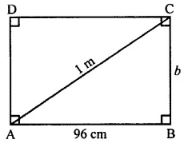
In right-angled triangle ABC,
By Applying Pythagoras Theorem,
(AC)2 = (AB)2 + (BC)2
= (100)2 = (96)2 + BC2
10000 = 9216
= BC2
10000 − 9216
= BC2
√784 = BC
∴ BC = 28 cm
Area of the rectangular board
= l × b or AB × BC
= 96 × 28
= 2688 cm2
Question 3.
The sides of a rectangular park are in the ratio 4 : 3. If its area is 1728 m2, find
(i) its perimeter
(ii) cost of fencing it at the rate of ₹40 per meter.
Answer
Ratio in the sides of a rectangle = 4 : 3
Area = 1728 m2
Let length = 4x, and breadth = 3x
∴ Area = l × b
1728 = 4x × 3x
⇒ 12x2 = 1728
⇒ x2=(1728/12)
⇒ x2 = 144 = (12)2
∴ x = 12
∴ Length = 4x = 4 × 12 = 48 m
Breadth = 3x = 3 × 12
= 36 m
(i)
Now perimeter = 2(l + b)
= 2(48 + 36) m
= 2 × 84
= 168 m
(ii)
Rate of fencing = ₹40 per metre
Total cost = 168 × 40
= ₹6720
Question 4.
A floor is 40 m long and 15 m broad. It is covered with tiles, each measuring 60 cm by 50 cm. Find the number of tiles required to cover the floor.
Answer
Length of floor (l) = 40 m
breadth of floor (b) = 15 m
∴ Area of floor = l × b = 40 × 15 = 600 m2
Length of one tile = 60 cm
=6/10 m
and breadth = 50 cm
= 5/10 m

Question 5.
The length and breadth of a rectangular piece of land are in the ratio 5 : 3. If the total cost of fencing it at the rate of ₹24 per meter is ₹9600, find its :
(i) length and breadth
(ii) area
(iii) cost of levelling at the rate of ₹60 per m2.
Answer
Ratio in length and breadth of a rectangular piece of land = 5 : 3
Cost of fencing = ₹9600
And rate = ₹24 per m
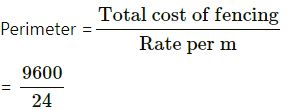
= 400 m
Let length = 5x
Then breadth = 3x
∴ Perimeter = 2(l + b)
400 = 2 × (5x + 3x)
∴ 16x = 400
x = 400/16
=25
(i)
∴ Length of land = 5x = 5 × 25
= 125 m
and breadth = 3x = 3 × 25
= 75 m
(ii)
Area = l × b
= 125 × 75
= 9375 m2
(iii)
Cost of levelling at rate ₹60 per m2
= ₹60 × 9375 m2
= ₹5,62,500
Question 6.
Find the area of the square whose perimeter is 56 cm.
Answer
Perimeter of square = 56 cm
⇒ 4 × Side = 56 cm
⇒ Side = 56/4cm
⇒ Side = 14 cm
∴ Area of square = (Side)2
= (14)2
= 14 × 14 cm2
= 196 cm2
Question 7.
A square lawn is surrounded by a path 2.5 m wide. If the area of the path is 165 m2 find the area of the lawn.
Answer
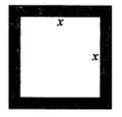
Area of path
= 165 m2
Width of path = 2.5 m
Let the side of square lawn = x m
so Outer side = x + 2 × 2.5
= (x + 5) m
∴ Area of path = (x + 5)2 − x2
⇒ x2 + 10x + 25 − x2
= 165
⇒ 10x = 165 − 25
= 140
⇒ x = 140/10
= 14 m
∴ Side of lawn = 14 m
and area of lawn = (14)2 m2
= 196 m2
Question 8.
For each figure, given below, find the area of shaded region : (All measurements are in cm)

Answer
(i)
Outer length = 20 cm
and breadth = 16 cm
∴ Outer area = l × b
= 20 × 16 cm2
= 320 cm2
Inner length = 15 cm
and Inner breadth = 10 cm
∴ Inner area = 15 × 10
= 150 cm2
∴ Area of shaded region = Area of whole region − Area of unshaded region
= 320 − 150 cm2
= 170 cm2
(ii)
Outer length = 30 cm
and Outer breadth = 20 cm
∴ Outer area = l × b
= 30 × 20
= 600 cm2
Inner length = 12 cm and inner breadth = 12 cm
Inner area = l × b = 12 × 12
= 144 cm2
Area of shaded portion = Area of outer figure − Area of inner figure
= 600 − 144
= 456 cm2
(iii)
Area of shaded portion = Area of outer region − Area of unshaded region
= 40 × 40 − 32 × 15
= 1600 − 480 cm2
= 1120 cm2
(iv)
Area of shaded region = Area of outer region − Area of inner region
= 40 × 40 − 15 × 15
= 1600 − 225
= 1375 cm2
(v)
Area of shaded portion
= 2 × 20 + 2 × 8 + 2 ×(12 + 2)
= 40 + 16 + 28 cm2
= 84 cm2
Question 9.
One side of a parallelogram is 20 cm and its distance from the opposite side is 16 cm. Find the area of the parallelogram.
Answer
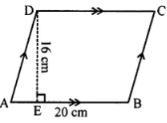
Area of parallelogram = Base × Height
= AB × DE
= 20 cm × 16 cm = 320 cm2
so Area of parallelogram = 320 cm2
Question 10.
The base of a parallelogram is thrice it height. If its area is 768 cm2, find the base and the height of the parallelogram.
Answer
Area of the parallelogram = 768 cm2
Let the height of the parallelogram = x
Then base = 3x
∴ Area = Base × Height
⇒ 768 = 3x × x
⇒ 768 = 3x2
⇒ x2 =768/3
= 256 cm
so x = 16×16
= 16 cm
so Base = 3 × 16
= 48 cm
and height = x = 16 cm
Question 11.
Find the area of the rhombus, if its diagonals are 30 cm and 24 cm.
Answer
Given, diagonal (d1) = 30 cm
Other diagonal (d2) = 24 cm

If AC and BD are the diagonals of a rhombus its

= 15 × 24 = 360 cm2
∴ Area of rhombus = 360 cm2
Question 12.
If the area of a rhombus is 112 cm2 and one of its diagonals is 14 cm, find its other diagonal.
Answer
Area of rhombus = 112 cm2
One diagonal = 14 cm
Let second diagonal = x
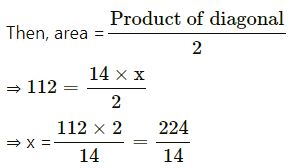
⇒ x = 16
∴ Second diagonal = 16 cm
Question 13.
One side of a parallelogram is 18 cm and its area is 153 cm2. Find the distance of the given side from its opposite side.
Answer
Area of parallelogram ABCD = 153 cm2
Side (Base) AB = 18 cm
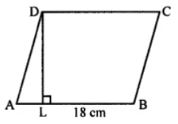
∴ Distance DL between AB and DC …..(altitude)

Question 14.
The adjacent sides of a parallelogram are 15 cm and 10 cm. If the distance between the longer sides is 6 cm, find the distance between the shorter sides.
Answer
In parallelogram ABCD
AB = DC = 15 cm
BC = AD = 10 cm

Distance between longer sides AB and DC is 6 cm
i.e., perpendicular DL = 6 cm
DM ⊥ BC
Area of parallelogram = Base × Altitude
= AB × DL = 15 × 6
= 90 cm2
Again let DM = x cm
∴ Area of parallelogram ABCD
= BC × DM
= 10 × x = 10x cm2
∴ 10x cm2 = 90 cm2
⇒ x = 90/10
= 9 cm
Question 15.
The area of a rhombus is 84 cm2 and its perimeter is 56 cm. Find its height.
Answer
Area of rhombus = 84 cm2
Perimeter = 56 cm
∴ Its side =564 = 14 cm
∴ Height =(Area of rhombus/Base)
=84/14
= 6 cm
Question 16.
Find the area of a triangle whose base is 30 cm and height is 18 cm.
Answer
Base of triangle = 30 cm
Height of triangle = 18 cm
∴ Area =((1/2)base×height)
= (1/2)×30×18
= 270 cm2
Question 17.
Find the height of a triangle whose base is 18 cm and area is 270 cm2.
Answer
Base of triangle = 18 cm
Area of triangle = 270 cm2
∴ Height = (Area×2/Base)
= (270×2)/18
=540/18
= 30 cm
Question 18.
The area of a right-angled triangle is 160 cm2. If its one leg is 16 cm long, find the length of the other leg.
Answer
Area of the right-angled triangle = 160 cm2
Let base (one side) = 16 cm
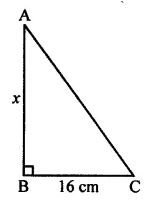
∴ Altitude (second side)
![]()
= 20 cm
Question 19.
Find the area of a right-angled triangle whose hypotenuse is 13 cm long and one of its legs is 12 cm long.
Answer
In right-angled Δ ABC,
Base BC = 12 cm
and hypotenuse AC = 13 cm
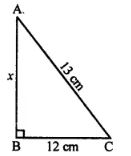
Applying Pythagoras Theorem,
(AC)2 = (AB)2 + (BC)2
(13)2 = (AB)2 + (12)2
169 = (AB)2 + 144
(AB)2 = 169 − 144
(AB)2 = 25
∴ AB =√25
= √5×5 = 5 cm
Now, area of Δ ABC = (1/2)base×altitude
= (1/2)×12×5
= 30 cm2
Question 20.
Find the area of an equilateral triangle whose each side is 16 cm. (Take = 1.73)
Answer
Side of the equilateral triangle = 16 cm

∴ Area = √3/4(a)²
=(√3/4)×16×16
= 1.73 × 4 × 16
= 110.72 cm2
Question 21.
The sides of a triangle are 21 cm, 17 cm and 10 cm. Find its area.
Answer
Let a = 21 cm, b = 17 cm and c = 10 cm
∴ a + b + c
= 21 cm + 17 cm + 10 cm = 48 cm
s = (a + b + c)/2
= (48/2)
= 24 cm
Area of the triangle

= 2 × 2 × 3 × 7
= 84 cm2
Question 22.
Find the area of an isosceles triangle whose base is 16 cm and length of each of the equal sides is 10 cm.
Answer
In isosceles Δ ABC
Base BC = 16 cm
and AB = AC = 10 cm
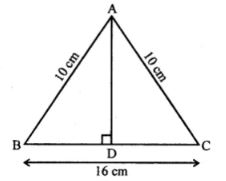
Let AD ⊥ BC and BD = (1/2)BC=16/2
∴ BD = 8 cm
In right Δ ABD
AB2 = AD2 + BD2 …………..(Pythagoras Theorem)
(10)2 = AD2 + (8)2
100 = AD2 + 64
100 − 64 = AD2
36 = AD2
AD = √36=√6×6
∴ AD = 6 cm
Now, the area of triangle =(Base×Altitude)/2
= 16×6/2
= 48 cm2
Question 23.
Find the base of a triangle whose area is 360 cm2and height is 24 cm.
Answer
Area of triangle = 360 cm2
and height (h) = 24 cm
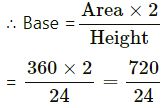
= 30 cm
Question 24.
The legs of a right-angled triangle are in the ratio 4 :3 and its area is 4056 cm2. Find the length of its legs.
Answer
Area of right-angled triangle = 4056 cm2
Legs of a right-angled triangled are in the ratio i.e. 4 : 3
Let one leg (Base) = 3x
Then second leg (altitude) = 4x
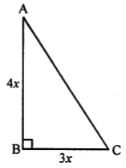

∴ x = 26 cm
∴ One leg (base) = 3x = 3 × 26
= 78 cm
and second leg (altitude) 4x = 4 × 26
= 104 cm
Question 25.
The area of an equilateral triangle is (64 x ) cm2– Find the length of each side of the triangle.
Answer
Area of equilateral triangle = 64√3 cm2
Let each side = a
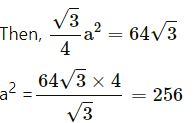
a = (16)2
∴ a = 16 cm
∴ Each side = 16 cm
Question 26.
The sides of a triangle are in the ratio 15 : 13 : 14 and its perimeter is 168 cm. Find the area of the triangle.
Answer
Perimeter of the triangle = 168 cm
Sum of ratio of sides = 15 + 13 + 14 = 42
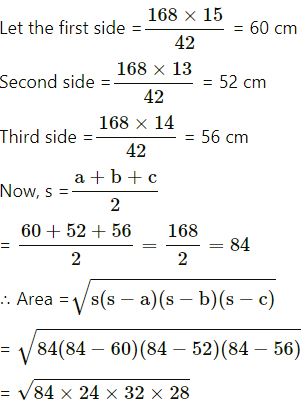
![]()
= 2 × 2 × 2 × 2 × 2 × 2 × 3 × 7
= 1344 cm2
Question 27.
The diameter of a circle is 20 cm. Taking π = 3.14, find the circumference and its area.
Answer
Diameter of circle (d) = 20 cm
SO. Circumference = dπ = 20 × 3.14 = 62.8 cm
Radius (r) = d/2
= 10 cm
∴ Area of a circle
= πr2
= 3.14 × 10 × 10
= 314 cm2
Question 28.
The circumference of a circle exceeds its diameter by 18 cm. Find the radius of the circle.
Answer
c be the circumference and d be the diameter of the circle.
∴ c = d + 18
⇒ dπ = d + 18
⇒ dπ − d = 18
d(π − 1) = 18
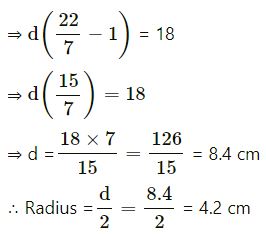
Question 29.
The ratio between the radii of two circles is 5 : 7. Find the ratio between their :
(i) circumference
(ii) areas
Answer
(i)
The ratio of the radius of the circles = 5 : 7
Let radius of first circle = 5x
and radius of second circle = 7x
∴ Circumference of first circle = 2πr
= 2π × 5x
= 10πx
and circumference of second circle
= 2π × 7x
= 14πx
∴ Ratio between their circumference
= 10πx : 14πx
= 10 : 14 = 5 : 7
(ii) Area of first circle = πr2
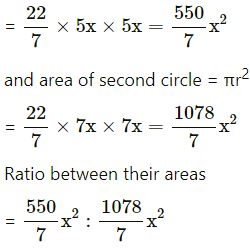
= 550 : 1078 …………(Dividing by 22)
= 25 : 49
Question 30.
The ratio between the areas of two circles is 16 : 9. Find the ratio between their :
(i) radii
(ii) diameters
(iii) circumference
Answer
(i)
Let radius of first circle = r1
and radius of second circle = r2
Given that ratio of the areas of circles = 16 : 9
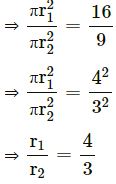
(ii)
the diameter of first circle = d1
and diameter of second circle = d2
Since, we know that diameter = 2 × radius
∴ d1 = 2 × r1 = 2 × 4x
= 8x
and d2 = 2 × r2 = 2 × 3x
= 6x
Now, the ratio between the diameter of two circles = d1 : d2
= 8x : 6x = 4 : 3
(iii)
Now, consider the ratio of circumference of the circles
![]()
so The ratio between the circumference of two circles = 4 : 3
Question 31.
A circular racing track has inner circumference 528 m and outer circumference 616 m. Find the width of the track.
Answer
Outer circumference = 616 m
Radius (R) = C/2π= (616×7)/(2×22)m
= 98 m
Inner circumference = 528 m
∴ Inner radius (r) =(528×7)/(2×2)m = 84 m
∴ Width of track = R − r
= 98 − 84
= 14 m
Question 32.
The inner circumference of a circular track is 264 m and the width of the track is 7 m. Find:
(i) the radius of the inner track.
(ii) the radius of the outer circumference.
(iii) the length of the outer circumference.
(iv) the cost of fencing the outer circumference at the rate of ₹50 per m.
Answer
Inner circumference of the circular track = 264 m
(i) ∴ Inner radius (r) = C/2π
= (264×7)/(2×22)
=(1848/44) = 42 cm
(ii) Width of the track = 7 m
∴ Outer radius (R) = 42 + 7 = 49 m
(iii) Outer circumference = 2πR
= 2×(22/7)×49
= 308 m
(iv) Rate of fencing = ₹50 per metre
∴ Total cost of fencing outer circumference = ₹50 × 308
= ₹15,400
Question 33.
The diameter of every wheel of a car is 63 cm. How much distance will the car move during 2000 revolutions of its wheel.
Answer
Diameter of car wheel (d) = 63 cm
∴ Circumference = πd = (22/7)×63 = 198 cm
Distance covered in 2000 revolutions
= 2000 × 198 cm
= (2000×198)/100 = 3960 m
= 3.96 km
Question 34
The diameter of the wheel of a car is 70 cm. How many revolutions will it make to travel one kilometre?
Answer
Diameter of car wheel (d) = 70 cm
∴ Circumference = πd = (22/7)×70cm
= 220 cm = 220/100 m
No. of revolutions in 1 km
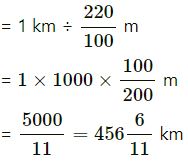
Question 35.
A metal wire, when bent in the form of a square of largest area, encloses an area of 484 cm2. Find the length of the wire. If the same wire is bent to a largest circle, find:
(i) radius of the circle formed.
(ii) area of the circle.
Answer
Area of the square made wire = 484 cm2
∴ Length (side) = √Area=√484 = 22 cm
(i) Perimeter of wire = 4 × Side
= 4 × 22 = 88 cm
∴ Circumference of circular wire = 88 cm
∴ Radius (r) = C/2π
=(88×7)/(2×22)cm = 14 cm
(ii) ∴ Area of the circle = πr2
= (22/7)×14×14 = 616 cm2
Question 36.
A wire is along the boundary of a circle with radius 28 cm. If the same wire is bent in the form of a square, find the area of the square formed.
Answer
Radius of circular wire = 28 cm
∴ Circumference = 2πr
= 2×(22/7)×28cm = 176 cm
∴ Perimeter of the square formed by this wire
= 176 cm
∴ Side (a) =176/4
= 44 cm
Area of square so formed = a2
= (44)2 cm2
= 1936 cm2
Question 37.
The length and the breadth of a rectangular paper are 35 cm and 22 cm. Find the area of the largest circle which can be cut out of this paper.
Answer
Length of rectangular paper (l) = 35 cm
Breadth of rectangular paper (b) = 22 cm

∴ Area = 35 × 22
= 770 cm2
The largest circle which can be cut from the rectangular paper will have a radius of 17.5 cm
∴ Area of a circle = πr2
= (22/7)×17.5×17.5
= 962.50 cm2
Question 38.
From each comer of a rectangular paper (30 cm x 20 cm) a quadrant of a circle of radius 7 cm is cut. Find the area of the remaining paper i.e., shaded portion.

Answer
Length of paper (l) = 30 cm
and breadth (b) = 20 cm
∴ Area of rectangular paper = l × b
= 30 × 20
= 600 cm
Radius of each quadrant at the corner = 7 cm
Area of 4 quadrants =4×(1/4)πr²
= πr2 = 227×7×7 = 154 cm2
∴ Area of remaining paper
= 600 − 154 = 446 cm2
— End of Mensuration ICSE Class-7th Solutions :–
Return to – Concise Selina Maths Solutions for ICSE Class -7
Thanks
